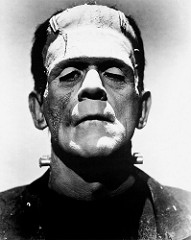
I’ve always been tall and big, and when I was growing up, I tended to identify with the large characters in teams or ensembles. To this day, I often find myself being self-conscious about how much space I’m taking up and whose view I might be obstructing. I was also very much a math and science nerd growing up, and even though I no longer do much with those subjects, I’ll get excited at the possibility of having an idea that could change the world. The part of me that is still eight years old, in applying that emotional logic to the Universal monsters, leads me to identify with both Frankenstein and his monster.
Acts of Varying Immorality
Of course, I don’t have anyone’s deaths on my conscience. Frankenstein’s monster, on the other hand, kills three people over the course of Universal’s Frankenstein, and attacks a few others. The extent to which he is aware of the moral consequences of his actions is up for debate, though.
(Oh, I’m skipping plot recap for this one – you almost certainly know the key details of the Frankenstein story already.)
The connection between the “abnormal” nature of the monster’s brain and his actions is fuzzy. Does he show so little remorse about killing Fritz the assistant and Dr. Frankenstein’s old professor because his physical brain used to belong to a criminal, who potentially had a skewed or nonexistent moral compass himself? Or are his actions more those of an animal reacting in self-defense to Fritz’s torment and the professor’s impending dissection?
The amount of brutality the creature displays certainly varies. The three deaths he causes – those of Fritz, the professor, and Maria, the little girl – follow a decreasing arc of murderousness. The monster straight up hangs Fritz, presumably with the whip the assistant used to torture the monster. The professor’s murder seems more of an act of self-defense. Despite having plenty of potential weapons at hand, the monster settles for strangling the old man. Maria’s death is the least intentional; it appears to be a misunderstood extension of the let’s-throw-pretty-things-in-the-water game (and it’s honestly a little surprising that she died of being tossed a few feet into the water). There’s no apparent ill will motivating the monster when he kills her.
However unintentional the monster’s killing of Maria may have been, there’s no question that his assault of Dr. Frankenstein’s fiancee, Elizabeth, is no fault of hers. She’s simply a tool of the monster’s quest for vengeance against Frankenstein. His later near-murder of Frankenstein comes in a moment of self-defense after his attempts to flee the angry villagers fail and is thus easier to defend. The attack on Elizabeth, though, makes the monster’s morality in the last act of the movie complicated. As sympathetic as he sometimes is, and no matter how much he may misjudge his own strength, he is not a blameless innocent.

The Monstrous Questions
This leads us to a pair of enduring questions in many monster stories, questions that Dracula didn’t raise. The simpler of the questions is, “Who is the real monster of this story?” The second is, “What makes someone (or something) a monster?”
The first question is in some cases too simplistic, but it’s proven fertile ground for plenty of stories. To pick just three movies from the last year, who are the real monsters of Beauty and the Beast, Kong: Skull Island, and The Shape of Water? Having an (often physically attractive) enforcer/hunter type human prove more monstrous in their actions than the ostensible monster has become a trope unto itself.
In the case of Frankenstein, while it’s the monster himself who does all the killing, his existence and behavior are the direct results of Frankenstein’s hubris and unwillingness to take responsibility, as well as Fritz’s cruelty. The monster’s appearance may be freakish and his reactions to physical threats too intense, but Frankenstein is the one who performs the unnatural act that brings the monster into being before immediately abandoning any interest in the monster’s mental or moral development. Fritz, meanwhile, is the only character who clearly takes delight from causing pain in others.
In many ways, Frankenstein leaves the issue less settled than the more recent movies I mentioned that clearly set out to subvert the idea of monstrousness. The monster himself is, in fact, a killer and prone to significant violence, and he clearly has enough presence of mind that he can’t be treated as a total innocent. And yet, I can’t help but feel that the greater monstrosities were committed by other characters.
(We’ll leave the don’t-play-God themes of the story for discussion in another post.)
You can already see how the first question sets up the second question of what makes someone or something a monster. Part of your answer to this will depend on your personal approach to moral philosophy. (As a brief aside, if you’re looking for some great introductions to various schools of thought, you could do a lot worse than watching The Good Place.)
We can start by considering the direct impact of a person or thing’s actions. Frankenstein’s monster kills, hurts, and intentionally terrifies several other characters. While he is undoubtedly sympathetic at times, especially when he seems most like a hunted or wounded animal, he is still a monster. Fritz, too, engages in monstrous behavior when he tortures the monster, but he never kills anyone.
However, Fritz also seems more aware of the consequences of his actions and to generally be functioning at a higher cognitive level than the monster. Considered from this perspective, he is the most wicked character in the movie. Granted, we don’t know his backstory. It’s possible that he has been on the receiving end of cruelty for much of his own life and is simply continuing the cycle of violence by tormenting a creature even lower in others’ estimation than Fritz himself is. Even if that’s the case, though, it seems clear that Fritz has a more comprehensive understanding of what he’s doing when he’s being violent than the monster does during most of his own episodes of violence.
And then we have Dr. Frankenstein, who does the fewest violent things out of these three characters, and yet without whom, none of the rest of the monstrosity would have been possible. He creates the monster, tolerates (and maybe even enables) Fritz’s torture of the monster, and is generally negligent in preparing for anything after his experiment succeeds. Even if the monster hadn’t wound up with an abnormal brain, it’s not at all outside the realm of possibility that a being brought to life that suddenly would require some combination of restraint and care. Yet Frankenstein appeared to have no plans for anything after his self-glorifying, “It’s alive! …Now I know what it’s like to be God!” moment.
Dracula doesn’t really invite us to consider these dimensions, as Dracula is unambiguously a self-aware killer and mind controller with no real sympathetic qualities. Whoever one considers the real monster or monsters of Frankenstein, they’re all more complicated in their monstrosity than the exsanguinary count.
Random Thoughts
One movie alone can’t really define a style, genre, or franchise. Early in 1931, Dracula opened the door to a new way of doing monster movies, and later that year, Universal lurched through the door with Frankenstein. The dual success of these movies set up the rest of the franchise (and the double feature showings of them a few years later would lead to the second wave of Universal monster movies such as The Wolf Man). Having now recently watched both movies, it’s easy to see why Frankenstein is often considered the superior of the two.
The pacing of shots and scenes in Frankenstein moves faster than Dracula, and the set design gives the sense of an even larger world than does Dracula’s. Additionally, the greater number of explicitly off-kilter Expressionist elements of the set design and lighting – which may warrant another post on their own – and the more dynamic camera work make Frankenstein more visually interesting as well.
And of course, there’s Karloff. Lugosi’s Dracula was an often-magnetic screen presence and an iconic performance, but Karloff takes his monster to the next level. He’s certainly aided in this respect by the makeup and costuming choices that lend him a more striking appearance than Lugosi’s well-dressed Dracula who’s so human-like we never see his fangs. Karloff’s performance relies on uncanny movements ranging from the very broad to the quite subtle, as well as on his grunting, whining lack of speech. The ultimate effect is to give us a monster unlike anything we’ve ever seen or would likely have conceived on our own.
Closing Thoughts
There’s so much more yet to say about Frankenstein, some of which will inevitably come out in the ongoing Penny Dreadful posts and the post on The Rocky Horror Picture Show coming in two weeks. Another post or two specific to this movie may also be coming. And we’ll certainly return to the Monstrous Questions in the future.
For now, I’m left meditating on the eight-year-old in me that still identifies somewhat with Frankenstein’s monster. I’m pretty sure I can avoid doing the kinds of things that made him a monster. The more unsettling question – as someone who’s been known to want to contibute to changing the world – is, can I can avoid the carelessness and hubris that made Dr. Frankenstein one, too?
